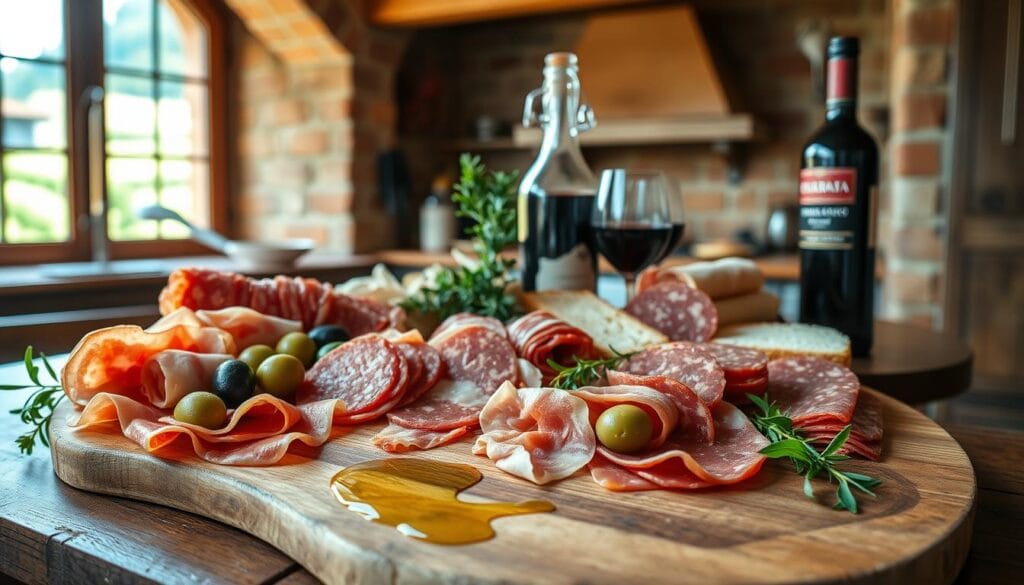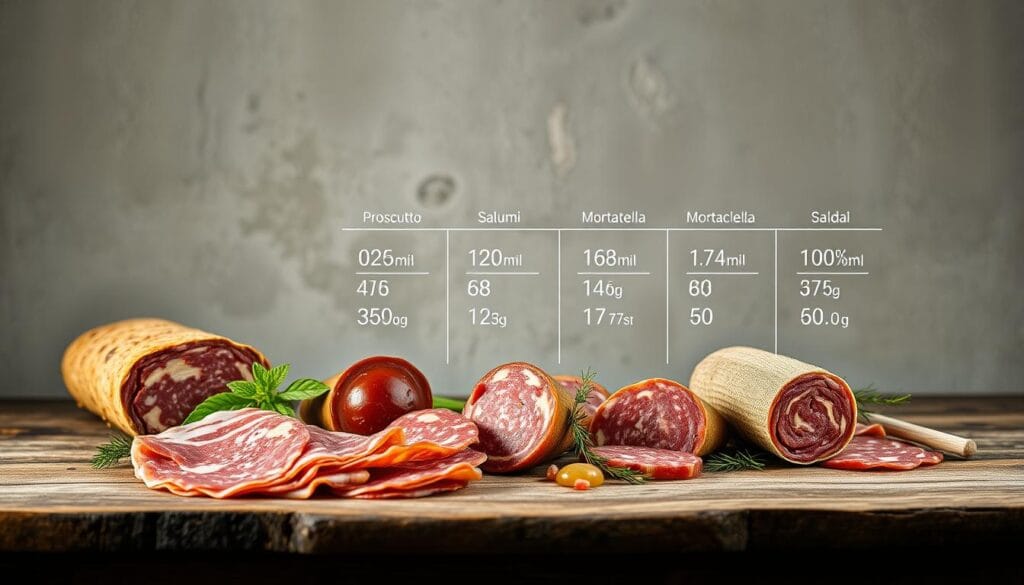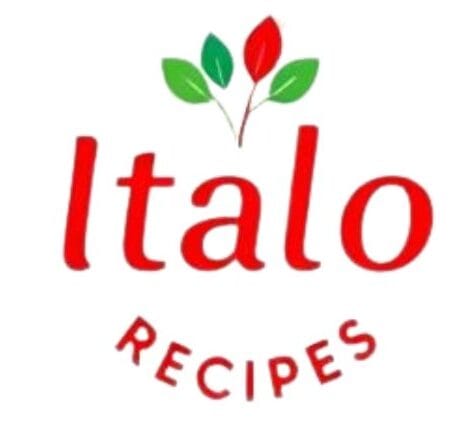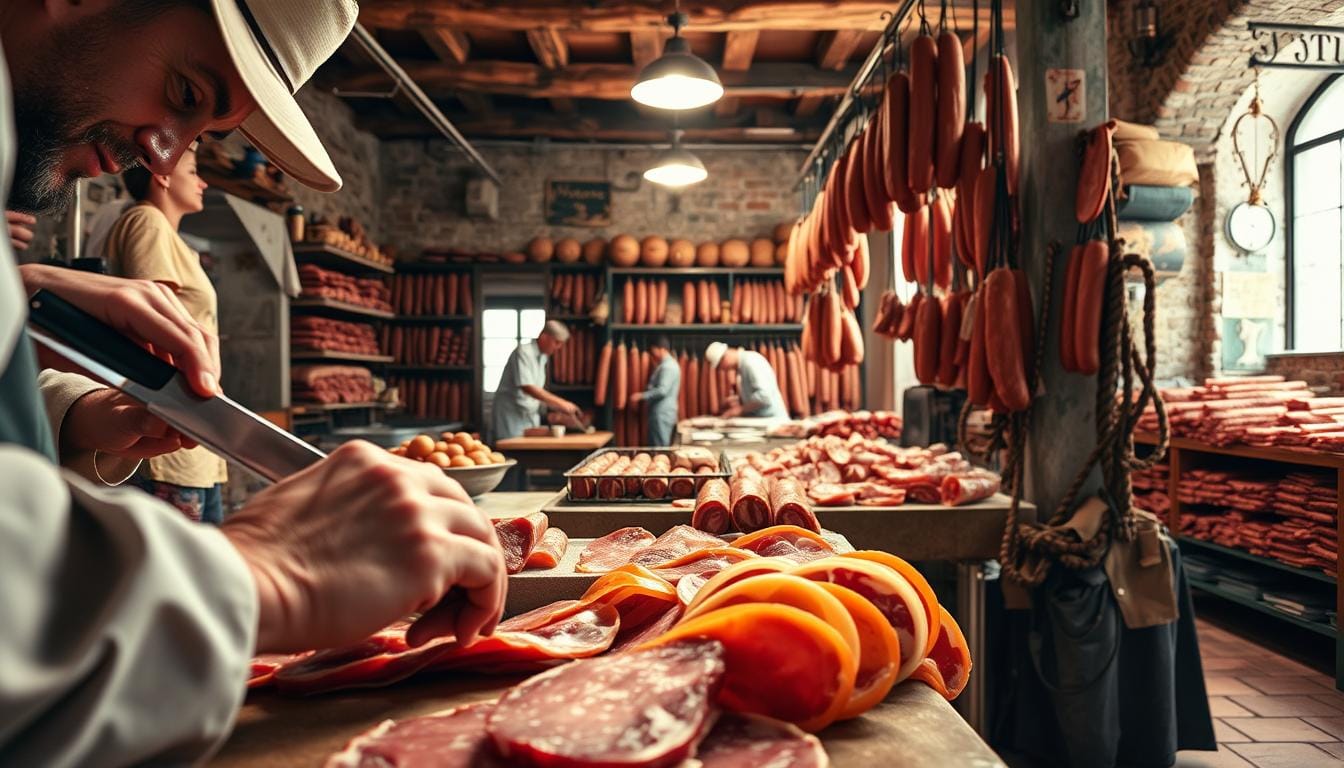Salumi nella tavola italiana 2025:Storia e Cultura Atraverso il tempo
La cultura dei salumi nella tavola italiana quotidiana:Have you ever enjoyed the rich flavors of Italian salumi? It’s more than just cured meat. It shows the Italian culinary heritage, shaped by centuries of tradition and cultural influences.
Exploring salumi reveals the stories behind its making. From the artisanal methods of Martelli and Raspini to the prestigious Premiata Salumeria Italiana. Italian salumi traditions show the country’s love for good food and community.
Learning about salumi’s role in Italian cuisine can deepen your appreciation for it. As we explore its history and culture, you’ll see how it brings people together and makes dining special.
Table of Contents
Key Takeaways
- Salumi is a cornerstone of Italian cuisine, reflecting the country’s rich culinary heritage.
- Artisanal production methods play a significant role in shaping the flavors and traditions of salumi.
- Understanding salumi’s cultural significance can enhance your appreciation for Italian food.
- Salumi brings people together, fostering a sense of community and shared tradition.
- The history and production of salumi are deeply intertwined with Italian culture.
The Rich Heritage of Italian Salumi Through the Ages
Exploring Italian salumi’s history reveals a tradition that’s centuries old. These cured meats have been a key part of Italian food, showing the country’s rich culture and geography.
Ancient Origins and Roman Influences
The history of Italian salumi goes back to ancient times. The Romans were known for their curing practices. Their cookbook, « De Re Coquinaria » by Apicius, has recipes similar to today’s salumi.
Preservation Techniques in Antiquity
Before refrigeration, preserving meat was essential. Salt, herbs, and spices were used to cure meats. This allowed for long-term storage. Experts say, « curing meat was a vital skill, passed down through generations. »
Cultural Significance in Roman Society
Salumi was more than just food in Roman society. It was a sign of wealth and status. Serving cured meats at banquets showed the host’s prosperity.
Evolution Through Medieval and Renaissance Periods
The medieval and Renaissance periods brought big changes to salumi. Guilds and regional specialties enriched the tradition.
Guild Systems and Artisanal Development
Guilds were key in salumi’s development. They ensured techniques were kept alive by skilled artisans. This led to high-quality products and traditional methods.
Regional Specialization Emergence
Trade and cultural exchange led to regional salumi specialties. Each region developed its own unique flavors and traditions. This diversity is what makes Italian salumi special today.
La cultura dei salumi nella tavola italiana quotidiana
Salumi is a big part of Italian culture, from family dinners to big celebrations. You might wonder how these cured meats became so important. It’s because of their rich history and traditions.
The Central Role of Salumi in Family Meals
In Italy, family meals are very important, and salumi is often the star. It can be a simple antipasto or a big spread. You can see this at an Italian family gathering, where salumi is a key part of the meal.
Daily Rituals and Antipasto Traditions
Enjoying salumi as part of an antipasto is a big tradition in Italy. You’ll find cured meats, cheeses, and more on the table. Popular ones include prosciutto di Parma and salami Toscano.
Intergenerational Knowledge Transfer
The art of making and enjoying salumi is passed down through generations. Family members share their skills and knowledge. It’s a way to keep cultural heritage alive through food.
Seasonal Celebrations and Salumi Traditions
Salumi is also key in Italian seasonal celebrations and festivals. During holidays, special types of salumi are made and served. It adds to the festive feel.
Holiday-Specific Varieties and Customs
Each holiday has its own salumi, with unique flavors and meanings. For Christmas, there’s prosciutto di Natale, cured just for the holiday.
Harvest Festivals and Seasonal Production
Italian regions celebrate harvest festivals, highlighting salumi production. You can see how meats are cured and preserved. It shows the connection between land, producers, and community.
By embracing these traditions, you can appreciate salumi’s role in Italian culture. Its flavors, heritage, and community bonding make it a big part of daily life and celebrations.
Regional Diversity: A Tour of Italy’s Salumi Landscape
Italy’s salumi landscape stretches from the Alps in the north to Sicily and Sardinia in the south. Each region offers a variety of authentic Italian salumi and artisanal Italian cured meats. These reflect local traditions and the use of local ingredients.
Northern Italian Specialties
Northern Italy is famous for its pork traditions. These are influenced by the Alps and cultural exchanges with neighboring countries.
Alpine Influences and Pork Traditions
The Alps have shaped Northern Italy’s salumi. Products like Bresaola, an air-dried beef, show the area’s unique curing techniques.
Lombardy and Piedmont Signatures
Lombardy and Piedmont are known for their artisanal salumi. They offer Prosciutto di Parma and Salame di Felino. These highlight the regions’ skill in curing and flavoring.
Central Italian Treasures
Central Italy, especially Tuscany and Emilia-Romagna, is celebrated for its salumi heritage. It combines traditional methods with local ingredients.
Tuscan and Umbrian Specialties
Tuscany and Umbria have unique salumi varieties. Finocchiona, a fennel-flavored salami, shows the regions’ creativity in salumi production.
Emilia-Romagna: Italy’s Salumi Heartland
Emilia-Romagna is the heartland of Italian salumi. Products like Prosciutto di Parma and Culatello di Zibello are iconic. They represent the region’s salumi craftsmanship.
Southern Italian Delicacies
Southern Italy, including Calabria, Sicily, and Sardinia, has its own distinct salumi traditions. These are often characterized by the use of local spices and ingredients.
Calabrian Spicy Traditions
Calabria is famous for its spicy salumi. ‘Nduja, a spicy, spreadable cured meat, reflects the region’s love for bold flavors.
Island Specialties of Sicily and Sardinia
Sicily and Sardinia have their own unique salumi. Sicily is known for its Salame di Felino-like products. Sardinia is famous for its Salumi Sardi. These show the islands’ distinct approaches to cured meats.
| Region | Notable Salumi | Characteristics |
|---|---|---|
| Northern Italy | Bresaola, Prosciutto di Parma | Air-dried, cured with salt and spices |
| Central Italy | Finocchiona, Culatello di Zibello | Fennel-flavored, high-quality pork |
| Southern Italy | ‘Nduja, Salumi Sardi | Spicy, unique island flavors |
The Art of Salumi Production
Exploring Italian cured meats reveals the art of salumi production. This craft combines ancient curing methods, quality ingredients, and knowledge of climate and terroir.
Traditional Curing Methods
At the core of Italian salumi production are traditional curing methods. Producers like Martelli and Raspini have honed these techniques over generations.
Salt Curing and Air Drying Techniques
Salt curing and air drying are key in preserving and flavoring salumi. Salt curing removes moisture from the meat. Air drying lets the meat mature slowly, enhancing its flavors and textures.
Smoking and Fermentation Processes
Smoking and fermentation add to the flavor of salumi. Smoking gives a savory taste. Fermentation creates complex flavors and tender textures.
The Role of Climate and Terroir
The climate and terroir of a region shape Italian salumi.
Microclimate Considerations
The microclimate of a region affects curing. For example, humidity and temperature in certain Italian areas are perfect for drying salumi.
Regional Ingredients and Their Impact
Local ingredients like salt, herbs, and spices make each salumi unique.
| Region | Curing Method | Notable Salumi |
|---|---|---|
| Northern Italy | Air drying and smoking | Prosciutto di Parma |
| Central Italy | Salt curing and fermentation | Finocchiona |
| Southern Italy | Salt curing and air drying | Sopressata |
Iconic Italian Salumi Varieties
Exploring Italian salumi reveals a world of iconic varieties. These show Italy’s skill in curing meats. It’s more than just preserving meat; it’s an art that tells Italy’s story.
Prosciutto: The King of Italian Cured Meats
Prosciutto is Italy’s most famous salumi. It’s known for its delicate taste and soft texture. This cured ham is aged to perfection, making it tender and flavorful.
Prosciutto di Parma vs. San Daniele
Prosciutto di Parma and Prosciutto di San Daniele are two top prosciutto types. They’re both made from pig’s hind leg but differ in taste. Prosciutto di Parma is sweet and fruity, while Prosciutto di San Daniele is delicate and nutty.
Lesser-Known Prosciutto Varieties
There are other famous prosciutto types like Prosciutto di Modena and Prosciutto di Carpegna. These offer unique tastes worth trying.
Salami Varieties and Their Characteristics
Salami is a key part of Italian salumi, known for its rich flavors and textures. Italian salami can be soft and spreadable or hard and sliceable, depending on where it’s made.
Hard vs. Soft Salami Traditions
Salami texture varies, with hard salami common in Northern Italy and soft in Central and Southern. Hard salami is aged longer, with a stronger flavor. Soft salami is spreadable and milder.
Regional Spice and Flavor Profiles
Italian salami has many flavors, shaped by local spices and ingredients. For example, Salami Toscano has garlic and black pepper, while Salami Veneto might include cinnamon and cloves.
Specialty and Lesser-Known Salumi
There are many Italian salumi beyond prosciutto and salami. These include offal-based salumi and rare products with protected designation of origin.
Offal-Based Varieties
Some Italian salumi use offal, like liver or heart, for unique tastes and textures. Mazzatello, for instance, is made from pork liver and other ingredients, showing Italy’s creativity.
Rare and Protected Designation Products
Some Italian salumi have protected designation of origin (PDO) status. This ensures their quality and authenticity. Nduja, a soft and spicy salumi from Calabria, is a great example, known for its rich taste and spreadable texture.
| Salumi Type | Region | Characteristics |
|---|---|---|
| Prosciutto di Parma | Emilia-Romagna | Sweet, fruity, aged for at least 24 months |
| Prosciutto di San Daniele | Friuli-Venezia Giulia | Delicate, nutty, aged for at least 13 months |
| Salami Toscano | Tuscany | Garlic and black pepper flavor, coarsely ground |
| Nduja | Calabria | Soft, spicy, spreadable |
The Craft of Pairing: Salumi in Italian Gastronomy

The art of pairing salumi with other foods and drinks is a key part of Italian culinary culture. Salumi is not just a side dish. It’s a main element that makes meals special.
Wine and Salumi: Perfect Companions
Pairing wine with salumi is a long-standing tradition in Italy. The secret to a great pairing is knowing the salumi and wine well. A strong salami goes well with a full-bodied red wine. A light prosciutto is better with a crisp white wine.
Regional Wine Pairings
Wines from different Italian regions pair well with local salumi. For example, a Sardinian prosciutto is enhanced by Cannonau wine. A Veneto region’s salami pairs well with Valpolicella.
Balancing Fat, Salt, and Acidity
A good pairing balances the fat and salt in the salumi with a wine’s acidity. A rich mortadella is balanced by a dry Rosé. The Rosé’s acidity cleanses the palate.
Complementary Foods and Flavor Profiles
Salumi is also paired with other foods for a perfect antipasto platter. The mix of textures and flavors is crucial.
Cheese, Bread, and Fruit Accompaniments
Salumi is often paired with cheese, bread, and fruit. For example, a spicy salami with creamy gorgonzola and sweet fig jam is a hit. The flavors contrast beautifully.
Creating the Perfect Antipasto Platter
To make an antipasto platter, start with salumi. Add cheeses, cured and fresh, and artisanal breads and crackers. Then, add fruits and nuts for sweetness and crunch. The result is a platter that looks great and tastes amazing.
From Tradition to Innovation: Modern Salumi Trends
The salumi industry is changing, focusing on quality and sustainability. Italian producers are mixing old techniques with new ideas. This is because people want to know more about their food’s origins and how it’s made.
Artisanal Revival and Craft Production
The salumi world is seeing a comeback of traditional methods. This is thanks to a focus on quality ingredients and craftsmanship. This movement is led by:
- Small-batch producers who care about quality and detail
- A commitment to sustainable and ethical production
Small-Batch Producers and Quality Focus
Small-batch producers are leading the artisanal revival. They make artisanal Italian cured meats that highlight Italy’s rich flavors and textures. Their dedication to quality and authenticity helps keep traditional techniques alive.
Sustainability and Ethical Production Methods
Sustainability is key in the salumi world now. Many producers use eco-friendly practices and buy from local, ethical suppliers. This improves the quality of their products and helps the environment.
Contemporary Interpretations and Fusion Approaches
The salumi industry is also seeing new ideas and fusions. This includes:
- Chefs experimenting with traditional salumi
- Introducing new flavors and ingredients from different cultures
Chef-Driven Innovation
Chefs are working with salumi producers to create new products. They mix traditional methods with modern tastes and ingredients. This results in unique Italian deli meats that attract a younger audience.
Cross-Cultural Influences and New Flavor Profiles
New ingredients and flavors are changing salumi. This adds excitement to traditional products. It makes them appealing to a wider range of people.
Nutritional Aspects and Health Considerations

It’s important to know the nutritional value of Italian salumi for a healthy diet. When you eat these cured meats, understanding their nutritional content helps you make better choices.
Nutritional Profile
Italian salumi is rich in protein, thanks to the meat used in making it. The fat content can change a lot, depending on the meat and curing process.
Protein, Fat, and Micronutrient Content
Salumi is a good source of protein and some micronutrients like zinc and vitamin B12. But, it can also have a lot of saturated fats and sodium.
Natural Preservation vs. Modern Additives
Traditional Italian salumi uses natural methods like salting and curing. But, modern production might use additives like nitrates. This can be a worry for those who care about their health.
Balancing Tradition with Modern Health Awareness
To enjoy Italian salumi healthily, think about eating smaller portions. Also, choose nitrate-free or lower-sodium options.
Portion Control and Dietary Integration
Eating salumi in moderation is essential. It can be part of a healthy diet when paired with other nutrient-rich foods.
Nitrate-Free and Reduced-Sodium Options
Some producers now make nitrate-free and lower-sodium salumi. This meets the need for healthier choices without losing flavor.
Conclusion: Embracing the Timeless Tradition of Italian Salumi
Exploring Italian salumi shows its deep role in daily life. It spans from the Alps to the Mediterranean. Salumi reflects Italy’s history, regional identities, and values.
The tradition of Italian salumi is not just about cured meats. It showcases Italy’s skill in preserving flavors. Traditional curing methods and climate create a variety of famous salumi.
As you delve into Italian salumi, try adding it to your meals and celebrations. Enjoy prosciutto with wine or salami with bread. You’re joining a tradition that connects people across the world and through time.

